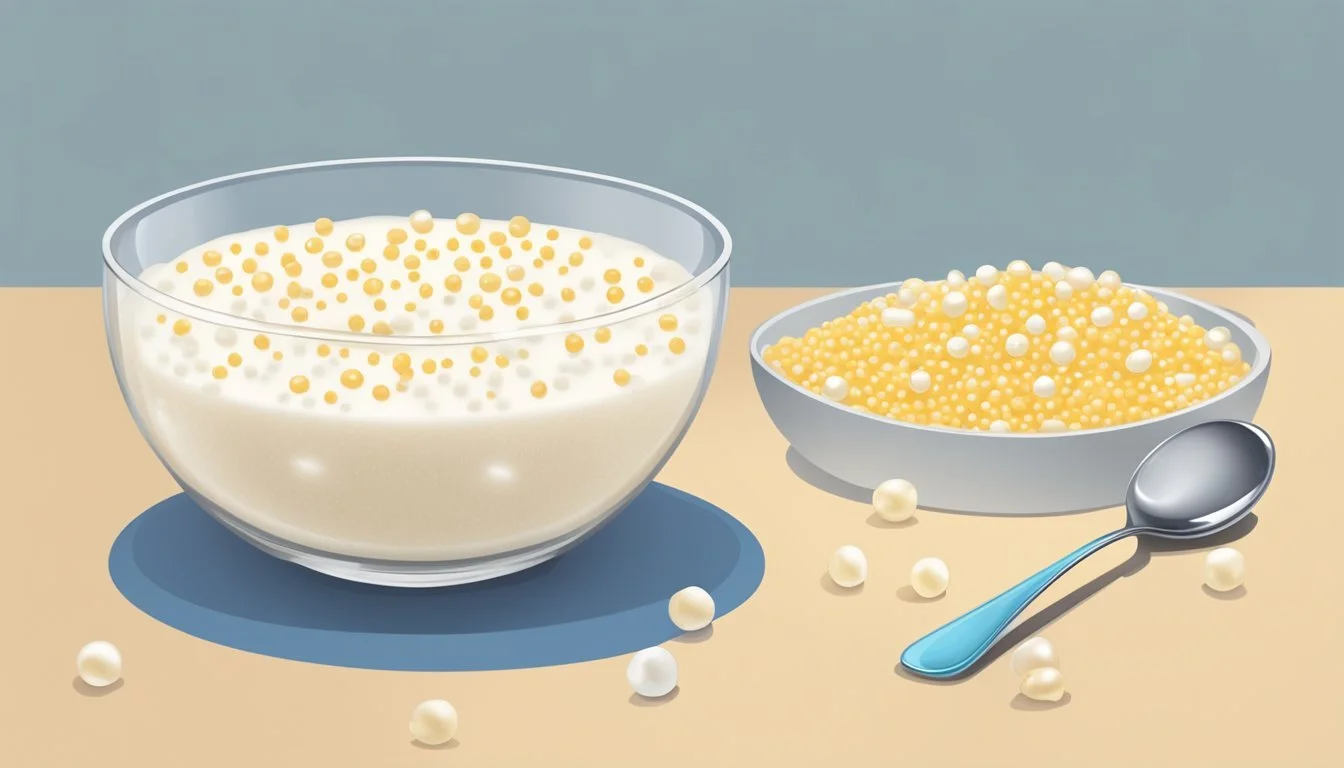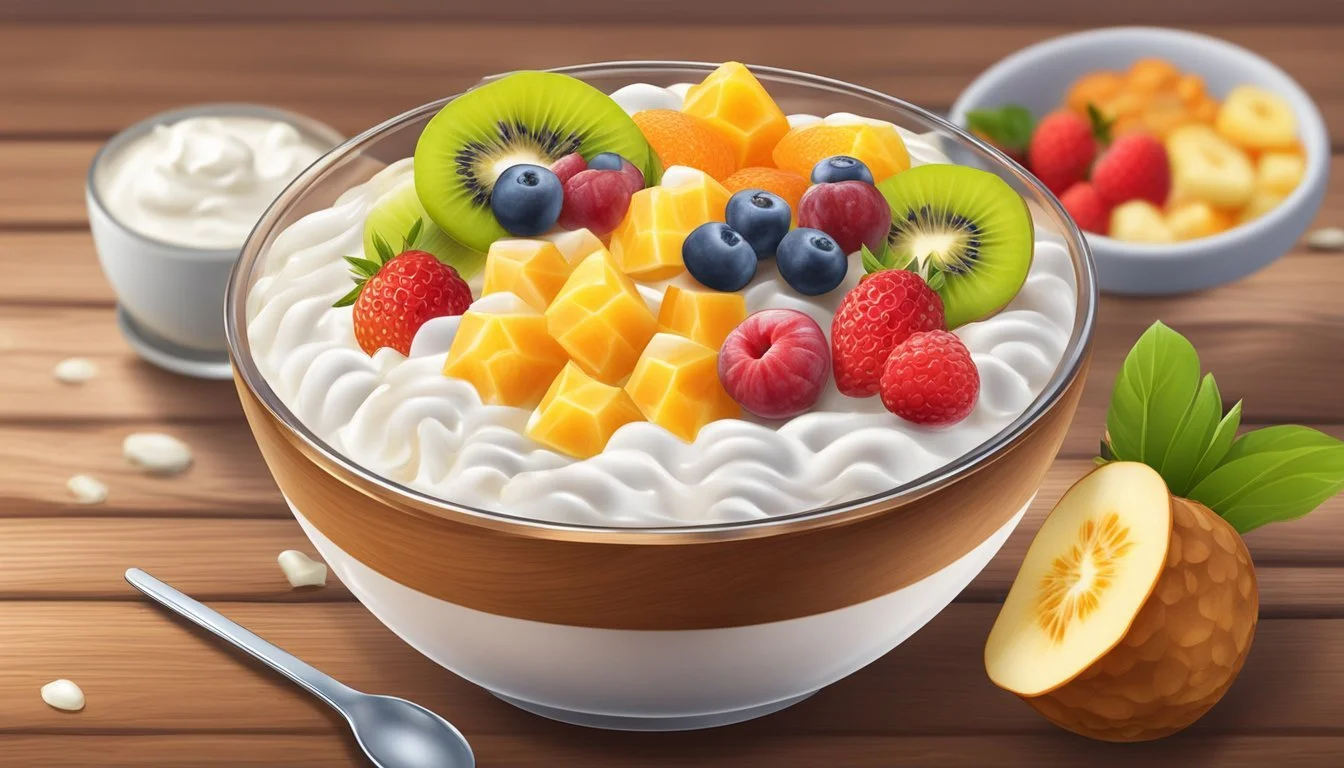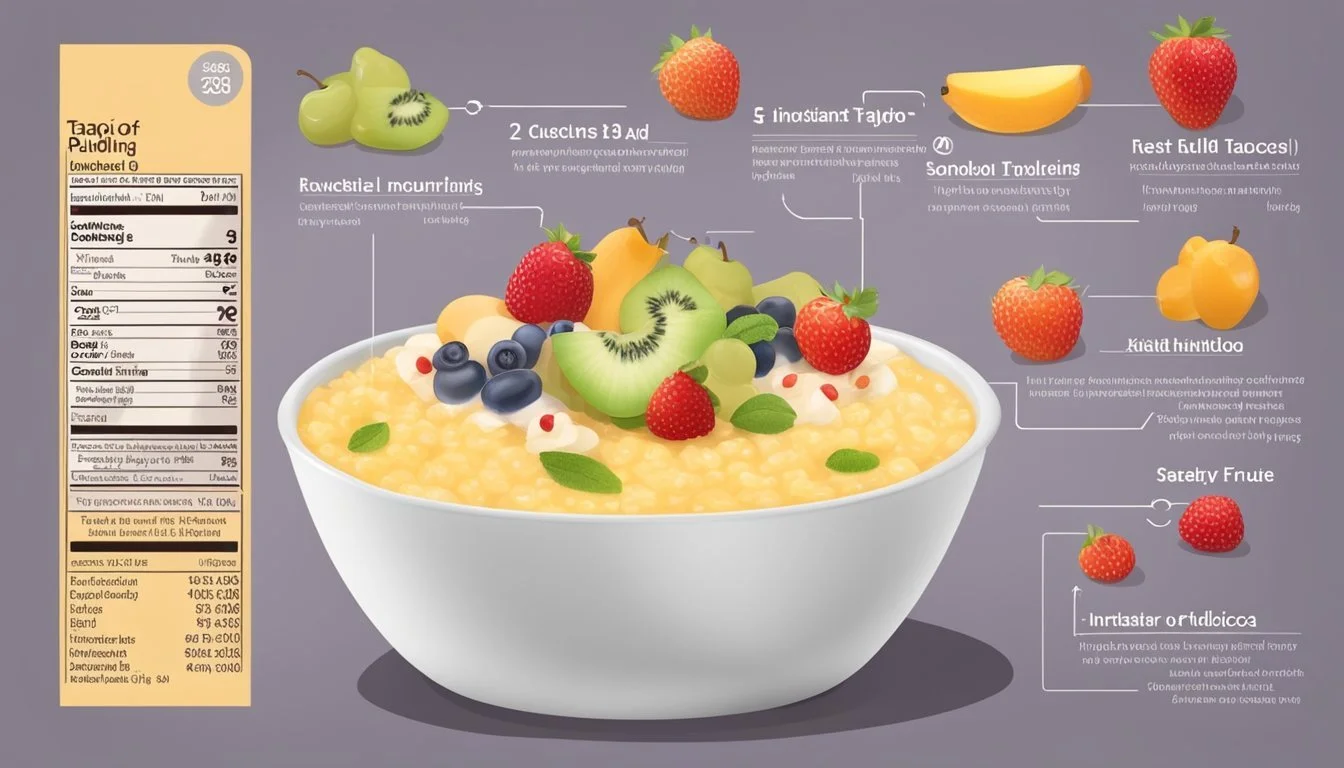Instant Tapioca Pudding Variations
Quick and Creative Twists on the Classic Dessert
Tapioca pudding is a classic dessert that stands the test of time, loved for its simplicity and comforting texture. Made from the starch of the cassava root, tapioca pearls are the hallmark of this creamy treat. The traditional approach involves soaking small, pearly spheres of tapioca before cooking them until they become translucent. Combined with milk, sugar, and sometimes eggs, the pudding transforms into a luscious dish with a delightful chewiness provided by the softened pearls.
Instant tapioca pudding offers a quicker alternative to the long-standing method, catering to the modern need for convenience without compromising the nostalgic allure of the original dessert. With an array of variations now available, the base recipe for tapioca pudding serves as a versatile canvas for a range of flavors and toppings. From the inclusion of vanilla extract for a subtle fragrant depth to the introduction of spices like cinnamon or nutmeg, each variation adds a unique twist that can enhance the pudding's character.
Beyond flavorings, the versatility of instant tapioca pudding allows it to adapt to various dietary preferences, including the use of alternative milks or sweeteners. This adaptability not only widens its appeal but also invites creativity in the kitchen, encouraging both seasoned cooks and novices alike to experiment with different combinations. Thus, instant tapioca pudding remains an endearing and adaptable dessert that continues to bring joy to those who savor its comforting embrace.
History of Tapioca Pudding
Tapioca pudding, often considered a classic dessert, has its roots in the cultural practices surrounding the cassava plant. The cassava root, a staple food in many parts of the world, is the source of tapioca. Native to South America, cassava made its way across the globe due to Spanish and Portuguese explorers.
Tapioca is derived from the starchy content of the cassava root, which is processed into small pearls. These pearls become translucent when cooked, providing the distinctive texture that characterizes tapioca pudding. The pudding itself is a simple dessert, consisting of tapioca pearls mixed with milk or cream and often sweetened.
In the early 19th century, tapioca pudding began to gain popularity in the United States and the United Kingdom. It was prized for its simplicity and the ease with which it could be made, as well as its comforting, creamy texture. The dessert was traditionally served hot, but over time, it became common to eat it chilled as well.
The dessert's popularity peaked in the mid-20th century, becoming a familiar staple in American households. Packaged and instant versions emerged, providing a quick and convenient option for those seeking the comfort of this traditional dish without the time-consuming process of soaking and cooking the pearls.
It should be noted that while tapioca pudding has a rich history, it has evolved over time. Today, it serves as a base for a variety of flavors and toppings, allowing it to adapt to modern tastes and preferences.
Understanding Tapioca as an Ingredient
Tapioca, often utilized in pudding and other desserts (What wine goes well with desserts?), is known for its unique texture and gluten-free nature. This section delves into the types of tapioca, its nutritional profile, and how it compares to rice pudding.
Tapioca Varieties
Tapioca comes primarily from the cassava root, which is processed to produce tapioca starch and pearls. Tapioca pearls vary in size, but they all share a signature translucent look after cooking. There are two main varieties:
Instant Tapioca: Also known as minute tapioca, this type cooks more quickly than other forms and is ideal for quick recipes.
Small Pearl Tapioca: Requires soaking before cooking, and it's used for traditional tapioca pudding recipes, offering a distinctly chewy texture.
Health and Nutrition
Tapioca is naturally gluten-free, making it a suitable starch for those with gluten sensitivities. However, it's important to consider its nutritional content:
Nutrient Content Calories Moderate Carbohydrates High Fiber Low Protein Negligible Vitamins/Minerals Limited
Tapioca should be consumed in moderation as part of a balanced diet due to its high carbohydrate content and limited overall nutritional value.
Tapioca vs. Rice Pudding
When comparing tapioca pudding to rice pudding, the key differences lie in texture and taste. Tapioca offers a chewier and more globular texture than the creamy, grainy consistency of rice pudding. Both are versatile and can be made into desserts or sweet snacks, but tapioca is a go-to ingredient for those seeking a gluten-free alternative.
Essential Ingredients for Tapioca Pudding
Creating the perfect tapioca pudding requires a blend of key ingredients that contribute to its creamy texture and sweet taste. The following subsections outline the essential ingredients needed for traditional or alternative versions of tapioca pudding.
Milk and Dairy Alternatives
Milk serves as the base for tapioca pudding, providing a rich and creamy texture. The choice of milk can vary based on dietary preferences:
Dairy-based: Whole milk or heavy cream is often used for a classic, indulgent pudding.
Dairy-free: Almond milk, coconut milk, and other plant-based alternatives cater to vegan or lactose-intolerant diets.
Eggs and Egg Substitutes
Eggs thicken the pudding and contribute to its custard-like consistency:
Traditional: Typically, whole eggs or egg yolks are whisked into the pudding mixture.
Egg-free: For a vegan or allergy-friendly option, ingredients like cornstarch or a commercial egg replacer can be used.
Sweeteners and Flavorings
The sweetness and aroma of tapioca pudding come from its sweeteners and flavorings:
Sweeteners:
Granulated sugar is a common choice for a classic sweet taste.
Alternatives: Honey, maple syrup, or even sugar-free sweeteners cater to different dietary requirements.
Flavorings:
Vanilla extract is essential for a rich vanilla flavor.
Variations: Vanilla flavor or no added sugar flavorings can provide the desired taste while modifying calorie and sugar content.
Instant Tapioca Pudding Preparation
Instant tapioca pudding offers a delightful dessert experience that can be achieved through various preparation methods, each tailored to suit different preferences and time constraints.
Classic Tapioca Pudding Techniques
To make classic homemade tapioca pudding on the stove, one begins by combining instant or minute tapioca with sugar, milk, and egg in a saucepan. It's essential to allow the mixture to rest for about 5 minutes to hydrate the tapioca before cooking. Over medium heat, the mixture is then brought to a boil while stirring constantly to prevent sticking. After reaching a boil, it is removed from heat and vanilla is stirred in. The pudding is then allowed to cool for about 20 minutes before it can be served either warm or chilled.
Prep Time: Approximately 5 minutes
Cook Time: Varies, until it reaches a full boil
Servings: Depends on the recipe
Quick Mixing Methods
Quick cooking tapioca allows for a faster preparation method. After mixing minute or instant tapioca with other ingredients, the mixture typically needs to sit for a short period, but less than with classic techniques. Frequent stirring is required on the stovetop to ensure even cooking and to avoid lumps. Upon removal from heat, a resting period allows for thickening, followed by refrigeration for those who prefer a chilled dessert.
Prep Time: Minimal
Cook Time: Reduced due to quicker boiling
Utilizing Modern Appliances
Modern appliances like the Instant Pot or an electric pressure cooker offer a hands-off approach to preparing instant pot tapioca pudding. By combining tapioca, water, and other ingredients in the pot, and selecting the appropriate setting (often the Rice function for around 7 minutes), one can achieve a pudding consistency after a natural pressure release. Stir in sugar and salt afterwards, and additional flavorings as desired. Using these appliances can dramatically reduce prep time and cook time, while typically yielding a consistent and satisfactory homemade tapioca pudding.
Prep Time: Quick setup
Cook Time: Set by the appliance (often around 7 minutes for instant pot)
Servings: Can vary based on the capacity of the pressure cooker
Variations and Flavors
Instant tapioca pudding easily adapts to a variety of tastes and dietary needs. One can infuse it with fruit, blend it with chocolate and spices, or modify it for specific diets.
Fruit-Infused Tapioca Pudding
Adding fruit to tapioca pudding is a splendid way to refresh a classic dessert. One can stir in fresh fruits like mango chunks or blueberries after cooking, or incorporate fruit purees for a more homogeneous consistency. Raisins are a traditional mix-in, often plumped beforehand for extra juiciness.
Apple Tapioca Pudding: Mix in diced, cooked apples with a sprinkle of cinnamon.
Mango Coconut Tapioca Pudding: Include mango puree and finish with coconut milk for a tropical twist.
Chocolate and Spice Variations
Chocolate and spices introduce a warm, comforting flavor to tapioca pudding.
Chocolate Tapioca Pudding: Melt chocolate into the hot pudding mixture and garnish with chocolate shavings.
Spiced Tapioca Pudding: Add a dash of ground spices such as nutmeg or cinnamon during cooking to infuse the pudding with warmth.
These additions not only enhance the flavor but also transform the texture, offering a satisfying experience for chocolate lovers.
Diet-Specific Adaptations
Dietary adaptations maintain the enjoyment of tapioca pudding while respecting individual needs.
For a vegan version:
Use plant-based milk alternatives like almond or soy milk
Opt for a plant-based sweetener in place of honey or sugar
For those requiring a dairy-free diet:
Coconut milk offers a rich, creamy base as a substitute for dairy
And, for a sugar-free dietary need:
Utilize sweeteners such as stevia or erythritol to replace sugar
These simple swaps ensure everyone has the chance to enjoy a delightful serving of tapioca pudding.
Accompaniments and Toppings
Instant tapioca pudding serves as a versatile dessert canvas, allowing for a myriad of delicious accompaniments and toppings to enhance its flavor and texture. By selecting from creams, syrups, nuts, fruits, and other inventive toppings, one can create a unique dessert experience with each serving.
Creams and Syrups
Whipped Cream: A dollop of whipped cream adds a light, fluffy contrast to the creamy texture of tapioca pudding.
Maple Syrup and Honey: Drizzling maple syrup or honey introduces a natural sweetness that pairs well with the subtle flavor of tapioca.
Nuts and Fruits
Fresh Fruit: Slices of banana, mango, or a medley of berries such as raspberries, blueberries, and strawberries offer a refreshing and tangy complement.
Dried Fruits (What wine goes well with dried fruits?) and Raisins: Incorporating dried fruits like raisins can bring chewiness and concentrated bursts of sweetness to each spoonful.
Suggested Fruit Combinations:
Fresh Fruit Dried Fruit Mango slices Raisins Banana slices Dried cranberries Mixed berries (raspberries, blueberries, strawberries) -
Nuts: Almonds or a wholesome trail mix provide a satisfying crunch and a rich, nutty flavor.
Alternative Topping Ideas
Chocolate: Whether in shavings or as a syrup, chocolate can transform a simple tapioca pudding into an indulgent treat.
Ice Cream: For a decadent twist, a scoop of ice cream on warm tapioca pudding makes for a delightful combination.
Spices: A sprinkle of cinnamon or nutmeg can introduce a warm spiciness that complements the pudding’s sweetness.
Using these suggestions, one can easily elevate a humble bowl of instant tapioca pudding into an extraordinary dessert that is as visually appealing as it is delicious.
Storing and Serving Tips
Instant tapioca pudding is a delightful treat when fresh, but it's essential to store and serve it correctly to maintain its taste and texture. These tips will ensure that your pudding remains delicious from the refrigerator to the table.
Proper Storage Practices
One should store tapioca pudding in an airtight container to retain freshness and prevent it from absorbing other flavors in the refrigerator. If an airtight container isn't available, covering the pudding with plastic wrap can also be effective, making sure it touches the surface of the pudding to prevent a skin from forming. Tapioca pudding can typically be refrigerated for up to 5 days.
Refrigerator Storage: Place pudding in the refrigerator within two hours of cooking to prevent spoilage.
Freezing: Freezing is not recommended, as it can alter the texture of the tapioca pearls, making them hard and chewy once thawed.
Reheating and Refreshing
To reheat tapioca pudding, one can use the microwave or a stovetop. When using a microwave, stir the pudding every 30 seconds to ensure even heating. On the stovetop, reheat the pudding over low heat, stirring frequently to avoid sticking or burning.
Microwave: Use a microwave-safe dish and cover lightly with plastic wrap or a microwave-safe lid to retain moisture.
Stovetop: Add a small amount of milk or cream if the pudding is too thick when reheating.
Presentation and Serving
Tapioca pudding should be served with care to enhance its appeal. Serve chilled or at room temperature based on preference. To elevate the experience, add a garnish such as a sprig of mint, a sprinkle of cinnamon, or fresh fruit like mango to add color and contrast.
Serving Suggestions: Always use a clean dish and spoon for presentation to keep the pudding sanitary and appealing.
Texture: Pudding consistency can vary; ensure a creamy texture for maximum enjoyment.
Nutritional Information and Dietary Considerations
When considering Instant Tapioca Pudding as a dessert option, it's important to examine its nutritional profile. Traditional tapioca pudding is made from tapioca pearls, milk, and sugar, and can be tailored to fit various dietary needs.
For a standard serving of tapioca pudding, one can expect:
Calories: Approximately 119 calories per 100 grams.
Carbohydrates: It has a high carbohydrate content, primarily from the tapioca pearls themselves.
Protein: A modest protein amount, with a 100-gram serving offering about 2 grams.
Individuals seeking a healthy dessert may consider modifying the traditional recipe by incorporating alternative ingredients. For example, replacing whole milk with coconut milk can cater to those looking for dairy-free options. For those monitoring their glycemic index, it's notable that tapioca has a high glycemic load, so portion control or alternative sweeteners could be considered.
Certain variations can be made to create a dessert that aligns with specific dietary preferences or restrictions:
Gluten-Free: Tapioca is naturally gluten-free, making it suitable for those with gluten sensitivities or celiac disease.
Vegan: By substituting dairy milk with plant-based milks, such as almond or soy, and replacing any animal-derived additives, the pudding can be made vegan.
No Added Sugar/Sugar-Free: For a sugar-free version, one might utilize sweeteners like stevia or erythritol.
Regardless of dietary preferences, it is feasible to tailor Instant Tapioca Pudding to meet diverse nutritional needs or health considerations with appropriate substitutions.
Tips for Perfect Tapioca Pudding
The key to perfecting tapioca pudding lies in mastering the consistency and texture, adjusting sweetness to taste, and understanding the nuances of cooking with different appliances.
Consistency and Texture
For the ideal consistency, small pearl tapioca is often preferred due to its ability to swell and absorb moisture, creating a smooth and pleasing texture. Remember to let the pearls sit for at least 5 minutes to properly hydrate before heating. Stir constantly to prevent sticking and cook until the pearls have plumped. Here is how the different sizes typically measure up:
Minute or instant tapioca: Quick-cooking, and a great thickener; works well for a speedy pudding, achieving the desired thickness without a prolonged cooking time.
Small pearl tapioca: Requires soaking and a longer cooking time than instant; results in a classic pudding texture.
Medium and large pearls: Yield a more rustic pudding with a pronounced chewiness; they may need pre-soaking and longer cooking times.
Adjusting Sweetness Levels
It is straightforward to tailor the level of sweetness in tapioca pudding. Granulated sugar is commonly used, but sweeteners like honey or maple syrup can offer additional flavor complexities and might be adjusted to personal preference. Use the following ratios as a starting point and then tweak according to taste:
Granulated sugar: The standard, with a clean, sweet taste; usually added in a 1:4 ratio with tapioca.
Honey: Adds a floral note; start with a bit less than sugar since it's sweeter and adjust.
Maple syrup: Provides a distinct autumnal flavor; can be used in a similar quantity to honey.
Cooking with Pressure Cookers
Pressure cookers, such as an Instant Pot, are convenient for making tapioca pudding. The enclosed environment cooks minute tapioca effectively, utilizing steam and pressure. Use the "Rice" or a similar low-pressure setting and allow for a natural pressure release to avoid sudden texture changes from a quick pressure drop. Cooking time varies based on the type of pearls:
For instant tapioca, cooking under pressure for 7 minutes followed by a 12-15 minutes natural pressure release tends to work well.
For minute or instant tapioca, avoiding high-pressure settings is crucial as it can cause the pearls to break down and lose texture.
By adhering to these fundamental principles, anyone can create a delicious tapioca pudding that satisfies their texture preferences and sweetness level using a variety of cooking methods, particularly pressure cookers.









